The Perfect Moist White Cake Recipe
As an Amazon Associate, I earn from qualifying purchases. Read the full disclosure here.
This perfect white cake recipe features a plush interior with a moist and velvety smooth crumb. Carefully chosen ingredients and a virtually foolproof method make this cake a long time reader favorite for good reason. Better yet, this beloved classic white cake recipe is the base for many other cakes on my website such as berry cake, champagne cake, rainbow cake, and confetti cake.
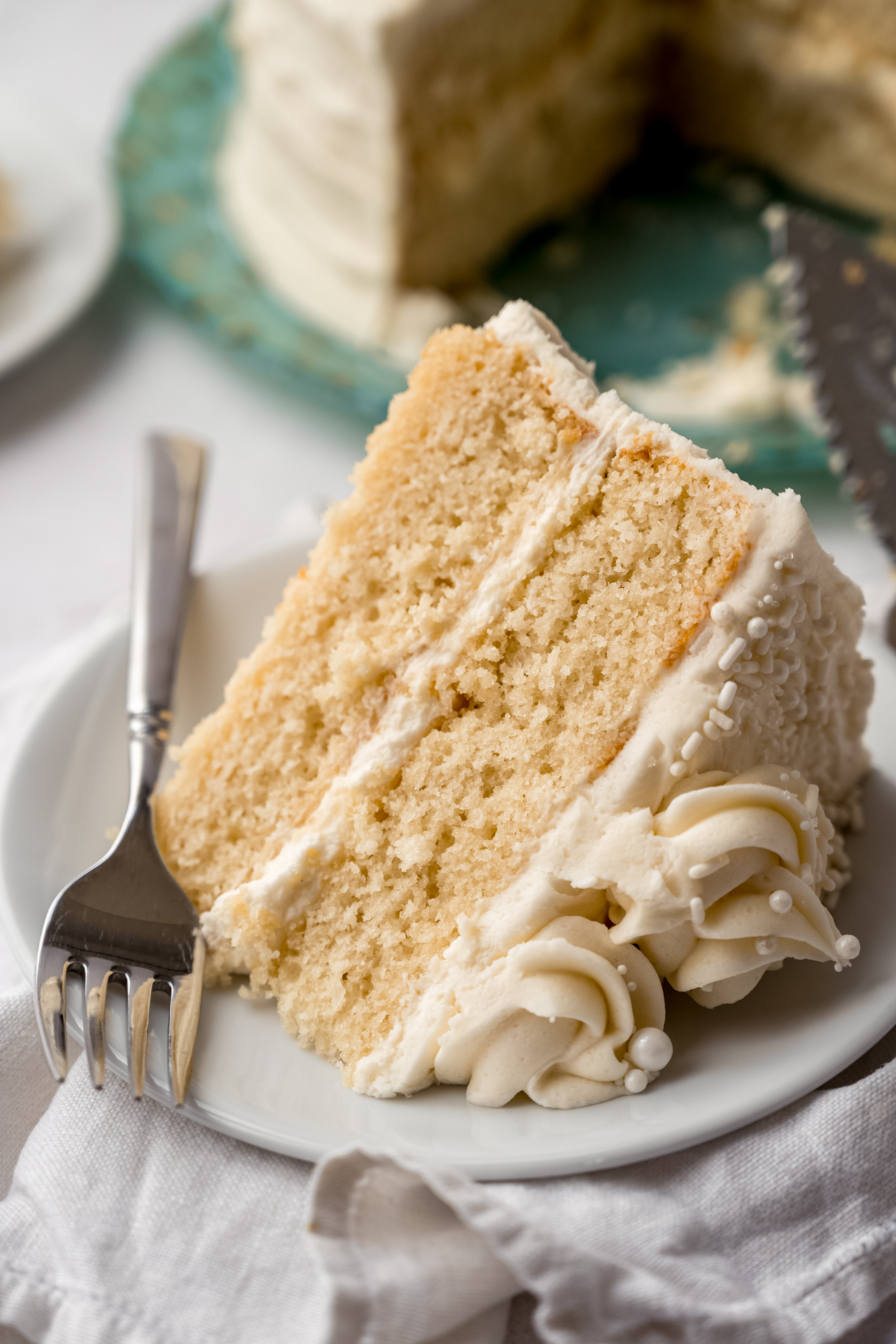
WHY THIS IS THE BEST WHITE CAKE RECIPE
As someone who has spent more than a decade and a half baking from scratch, and whose first specialty was cakes, believe me when I say that this is the only white cake recipe you will ever need for the rest of your baking life. Period.
It’s so reliable that it lays the framework for so many of the cake recipes on my site, and no matter how many other cakes have stolen my heart with just one bite (like, even my beloved carrot cake), this simple cake recipe has never not been at the top of my “basic favorites” list.
WHAT EXACTLY IS WHITE CAKE?
I get it, descriptions of cakes are often confusing, but first things first, white cake is, well, white. It’s not quite angel food cake white, since it does use plenty of butter, but you won’t be adding any egg yolks to this cake batter, so the batter stays fairly white, especially in comparison to its cousin cake, the yellow cake and half sibling vanilla cake.
Egg whites are the bulk of the glue that holds this whole cake business together, and you’ll need 6 of them for this two layer cake. I know, that’s a lot of unused egg yolks, but save them, toss them in an egg casserole, or use cartoned egg whites (see my notes in the ingredient section of this post or the notes section of the recipe card below).
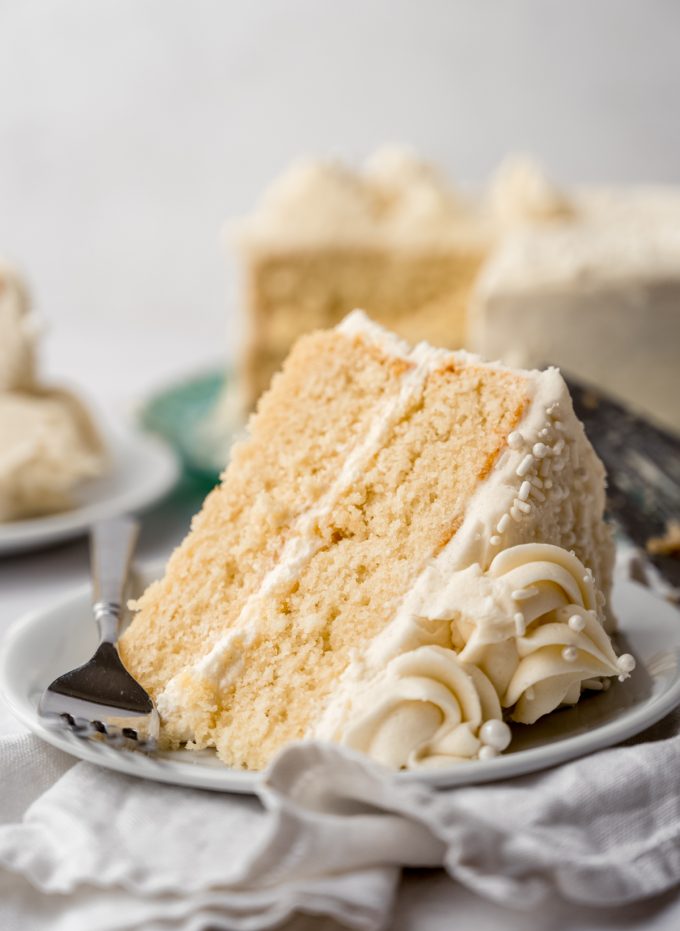
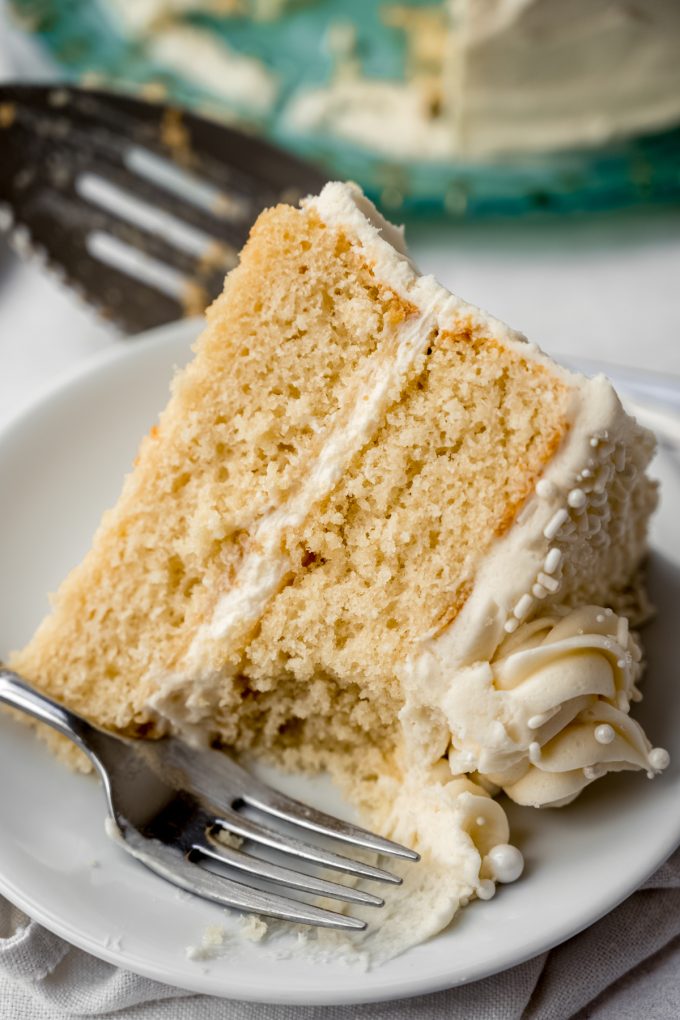
WHAT THIS WHITE CAKE RECIPE TASTES LIKE
I used this recipe to make many many cakes for customers back in my cake baking/decorating days, and it was often referred to as “that wedding cake flavor” when I would ask customers to be specific when asking for a “white” cake (spoiler alert: often times, they really wanted yellow cake).
But do you know the cake I’m talking about? Dense but not heavy, the perfect amount of moisture, a tight crumb that flows seamlessly into the filling and/or frosting surrounding it?
Hopefully you’ve tried the cake I’m describing, and you’re nodding your head in wedding cake delight. Are we on the same cake page now?
Mmm… That page sounds yummy. But I digress.
THE REVERSE CREAMING METHOD: WHY YOU’LL LOVE THIS WHITE LAYER CAKE
We lean into my favorite cake making method, reverse creaming, which makes this recipe virtually foolproof and one that you’ll be baking again and again (you’ve been warned!). There are many reasons why I love this method, and if you’ve never utilized this method before, I think we can turn you into a believer!
NO CREAMING: this is quite possibly my favorite thing about the reverse creaming method! There’s no “is this mixture light and fluffy yet? How long have the sugar and butter been creaming? Did I cream them too much?” The reverse creaming method means you’ll add the softened butter right in with the sugar and other dry ingredients.
MIX, POUR, BAKE: since we aren’t creaming anything, the method for this cake feels as easy as a box mix with some ownership. Making the batter for this cake recipe means you just add all the ingredients (in a specific order, don’t let the rules go out the window!) to a bowl, pour the batter into your cake pans, and bake. It’s a one-bowl wonder (we love those around here).
NO TRIMMING: one of the amazing things about the reverse creaming method is that it’s kind of magical in that it produces flatter, more evenly baked cake layers. This method minimizes gluten development and air incorporation meaning the layers won’t dome during baking and they’ll wind up with a velvety smooth and delicate crumb.
Moist White Cake Recipe Ingredients
Nothing fancy here, but be sure you’re paying attention to these carefully chosen ingredients so your results are perfect.
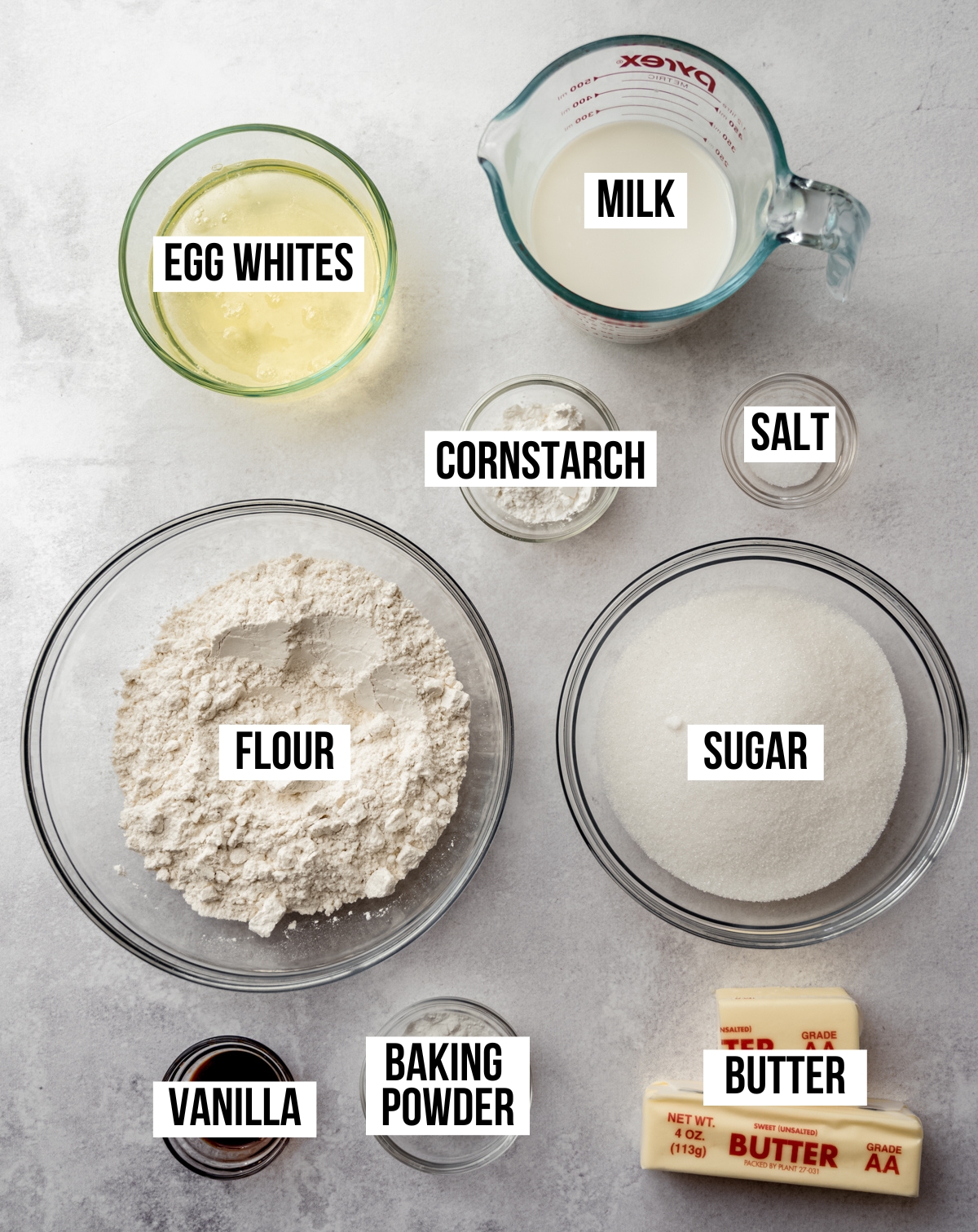
ALL-PURPOSE FLOUR + CORNSTARCH: this recipe is adapted from Cook’s Illustrated which is a white cake recipe with cake flour. While I typically do have cake flour on hand, I find that using a DIY cake flour mixture of all-purpose flour and cornstarch yields the same results and makes this cake recipe more accessible to home bakers. Cake flour, even the DIY version, means a lighter, softer, and more delicate cake texture when compared to cake made with just all-purpose flour. Not only that, but this combination also means a superbly moist crumb as cornstarch helps absorb moisture.
GRANULATED SUGAR: no brown sugar in this cake because, remember, we want to keep it white.
BAKING POWDER: no acidic ingredients in this cake to activate baking soda, so we’re relying solely on baking powder to bring all the lift to this white cake recipe.
SALT: this perfectly offsets the sweetness of the cake. Don’t leave it out!
UNSALTED BUTTER: be sure your butter is at room temperature and no warmer. Anything warmer than room temperature and you run the risk of a greasy cake.
WHOLE MILK: whole milk is crucial to the texture of this cake. While you can use a lower fat milk or even a non-dairy one, whole milk produces the best balance of moisture and richness without weighing down the cake crumb.
EGG WHITES: while fresh eggs are my preference, you can use cartoned egg whites for this particular recipe. Aim for 30g per egg white as opposed to the 46g on the carton.
VANILLA EXTRACT: be sure you’re using pure vanilla extract since that’s all we get in this white cake!
How to Make White Cake with Buttercream Frosting
I like to make this cake in two 8″ round cake pans, though it will work in 9″ rounds as well as three 8″ rounds. See recipe notes for adjusting bake times based on the pans you have.
STEP #1: start by combining the flour, cornstarch, sugar, baking powder, and salt, then blend the ingredients together on low until completely combined.
STEP #2: add the butter and beat the mixture on low speed until it resembles sand. Scrape down the sides and bottom of the bowl with a spatula and mix again on low for a few seconds until everything is thoroughly combined.
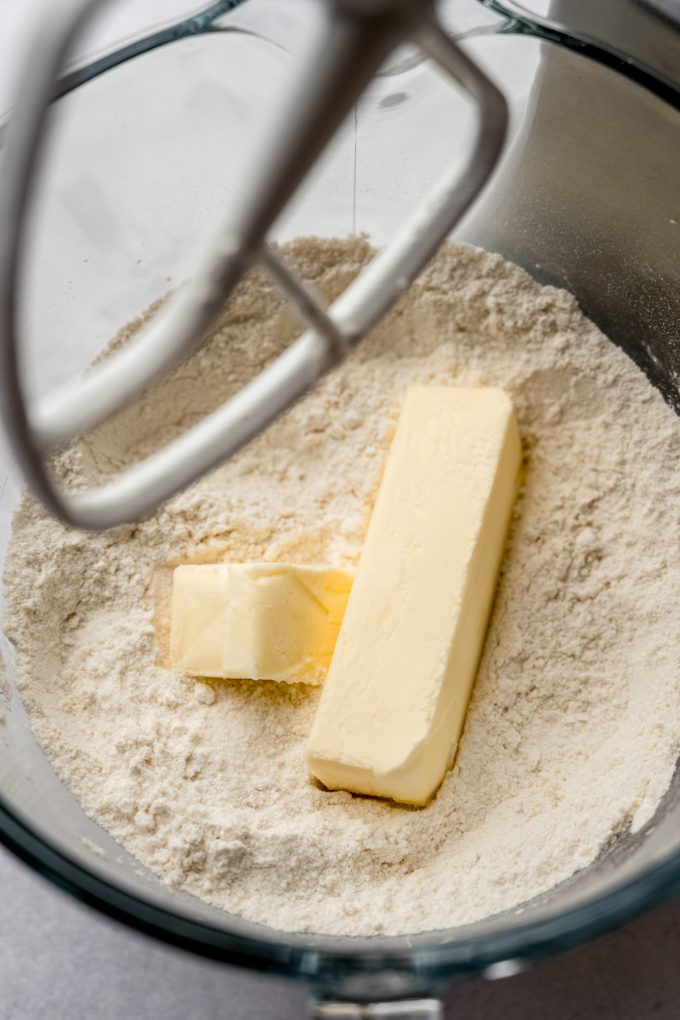
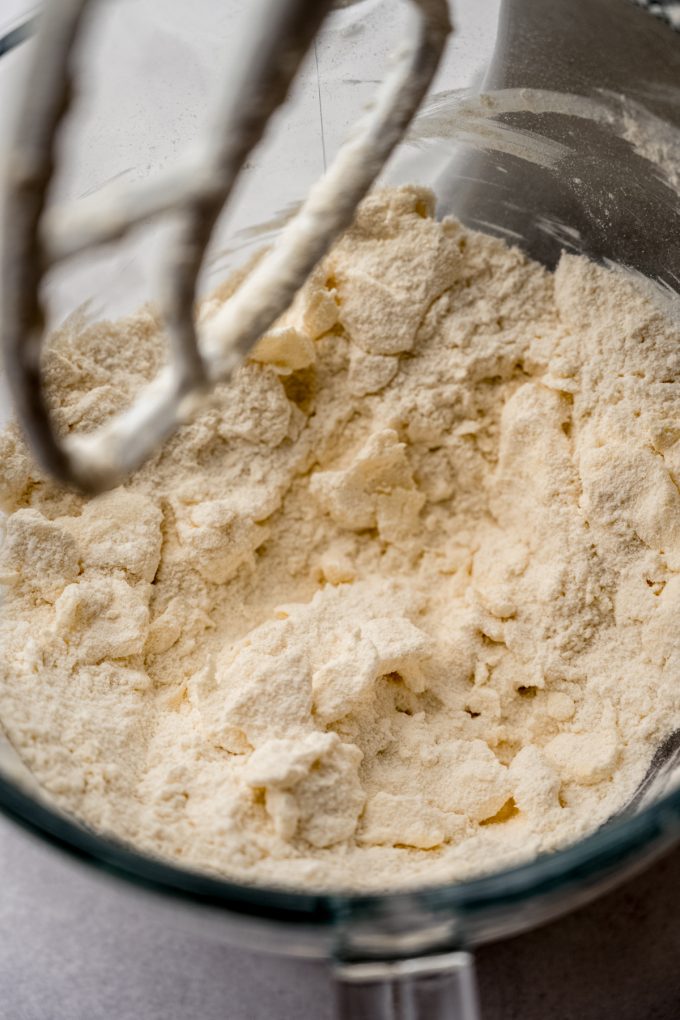
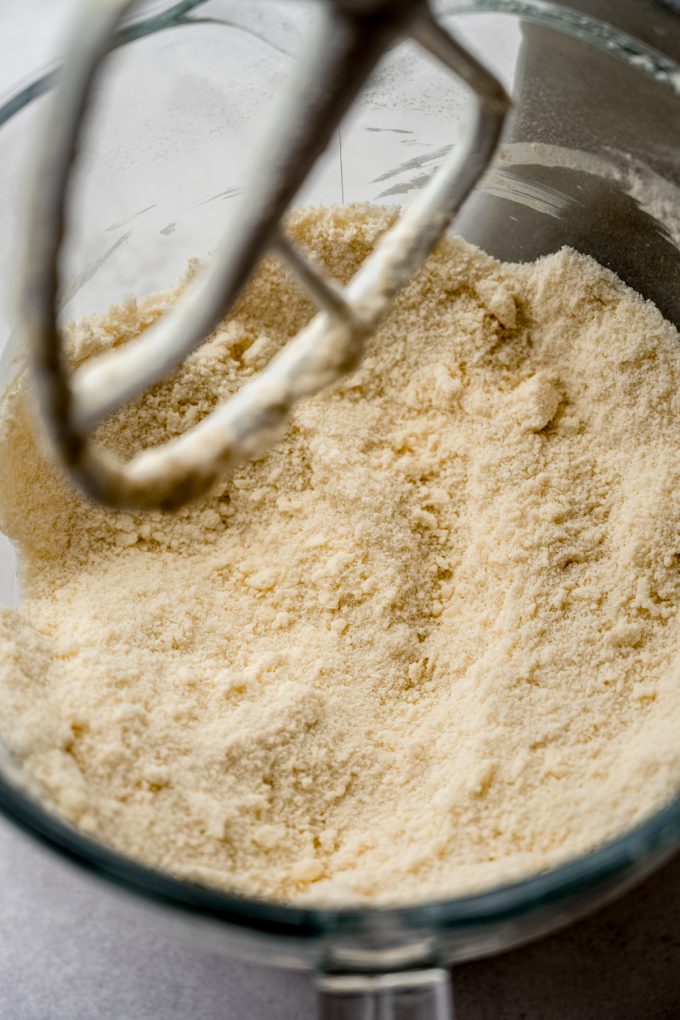
STEP #3: combine the milk, egg whites, and vanilla extract in a large container with a spout (like a 2-cup glass measuring cup) and mix gently with a fork until blended.
STEP #4: with the mixer speed on medium-low, add half of the milk mixture (about 1 cup) to the crumb mixture and mix until blended. Add the remaining milk mixture to the batter and beat again on medium-low until everything is incorporated. Turn the mixer off, scrape down the sides and bottom of the bowl with a spatula, and increase mixer speed to medium. Beat the batter for about 30 seconds until batter is smooth.
THE IMPORTANCE OF SLOWLY ADDING IN THE LIQUID
Your batter can only absorb so much liquid at one time. In order not to overload it with too much at once, adding it in two parts ensures there’s enough room for everyone to be happy and work together properly. It may seem like an unnecessary step, but trust me, it is crucial in producing the perfect texture for this cake.
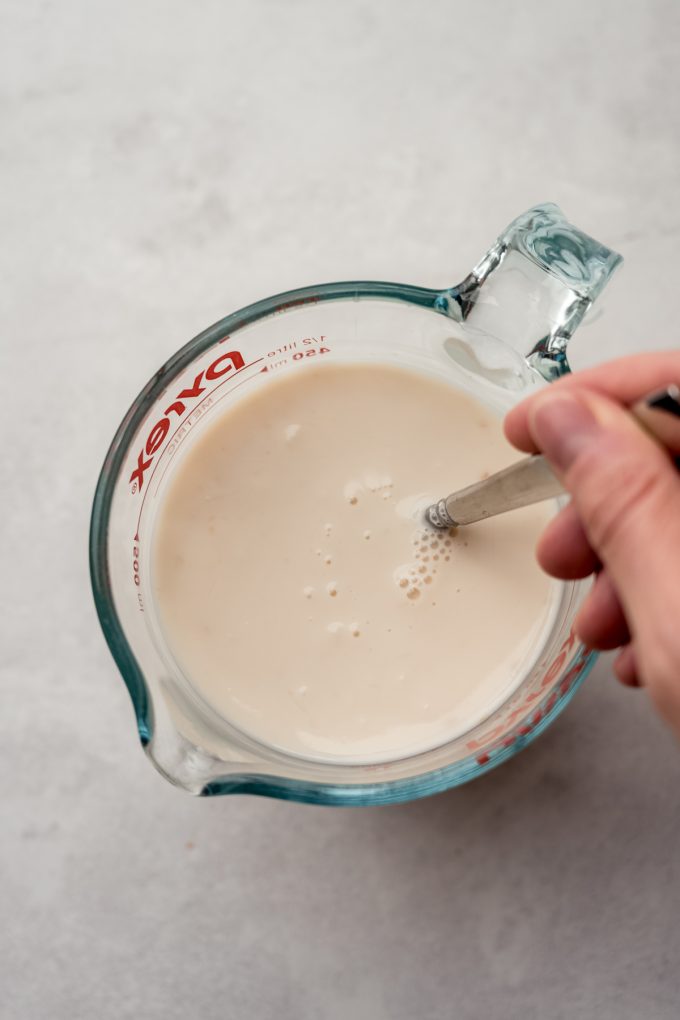
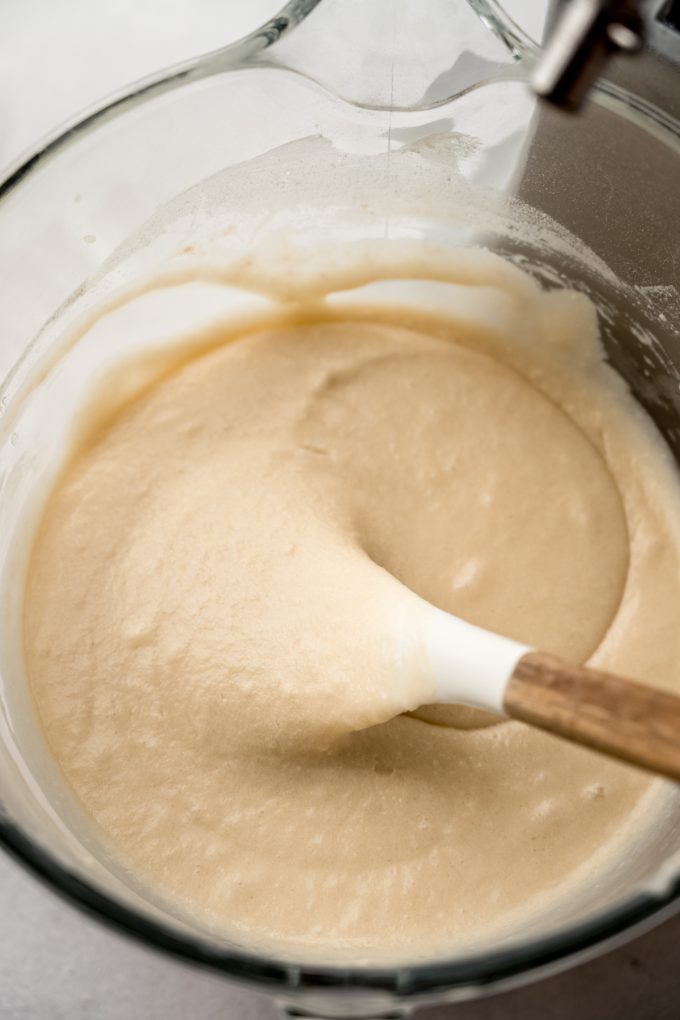
STEP #5: divide batter evenly between the prepared cake pans, then bake. Allow the cakes to cool in the pans completely on a wire rack before removing and assembling.
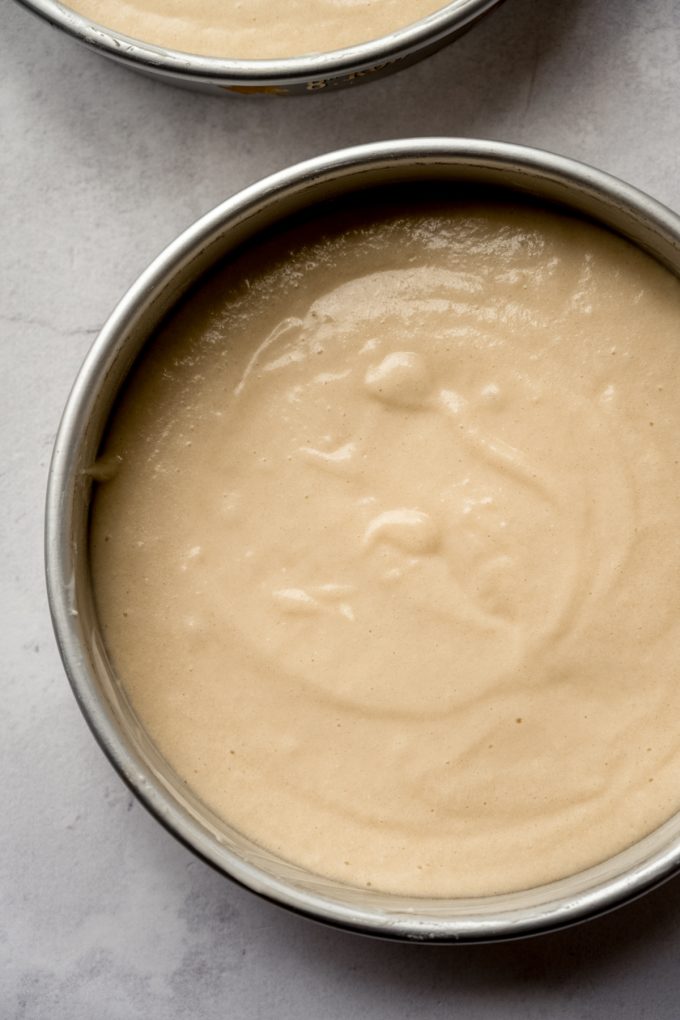
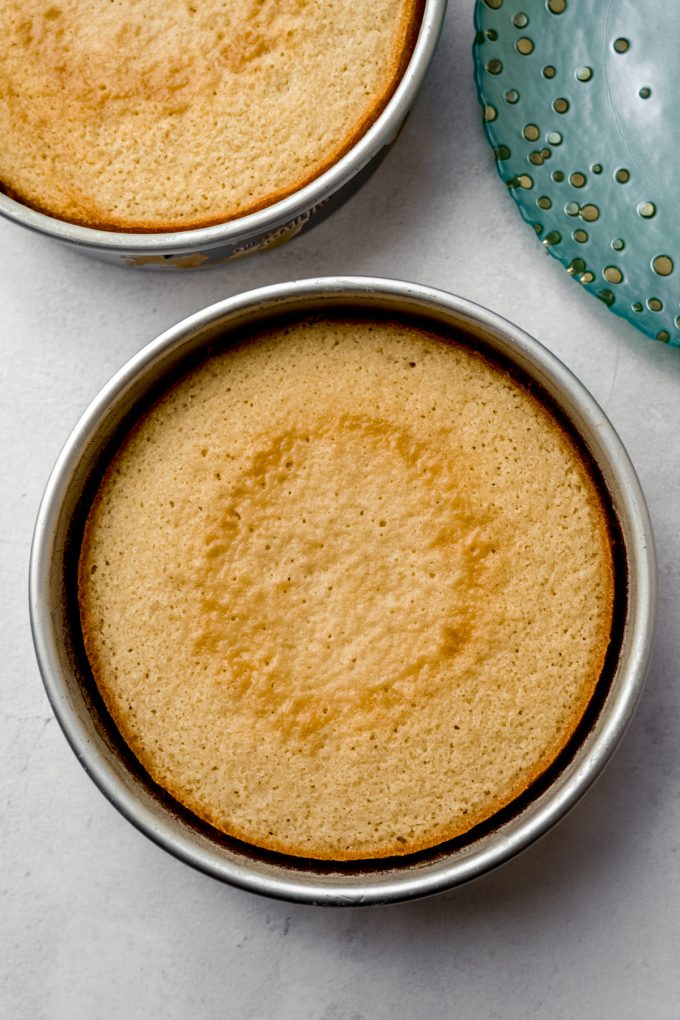
White Cake Frosting: You Have Options!
While the recipe card below uses classic vanilla frosting, you can pair this cake with any frosting you like.
Consider using cream cheese frosting, Swiss meringue buttercream, or any other American buttercream that your cake-loving heart desires.
HOW TO DECORATE WHITE CAKE WITH BUTTERCREAM FROSTING
As always, allow your cake layers to cool completely before assembling, and remember that no cake is complete without sprinkles. And some swirls.
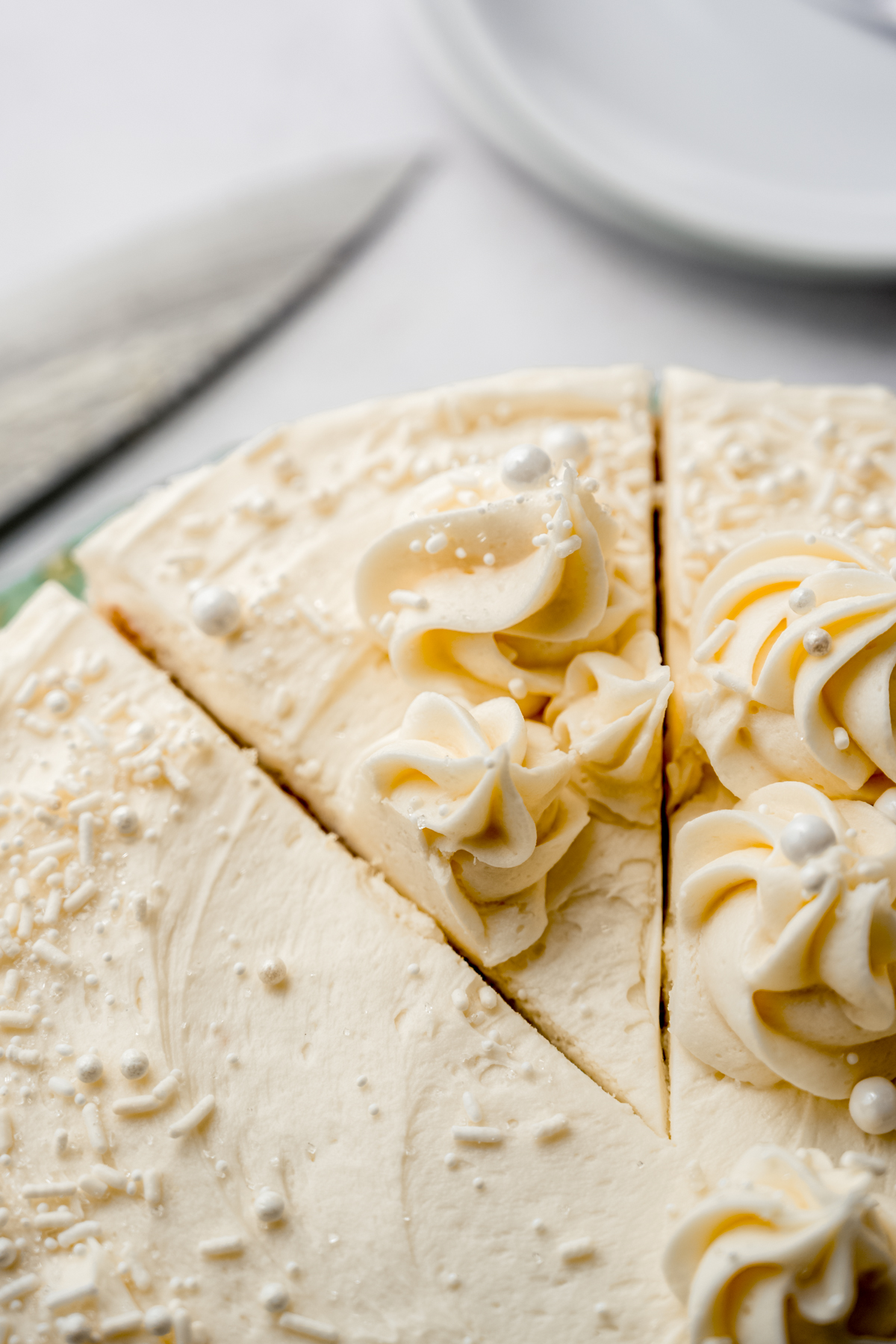
How to Store Moist White Cake
Note: This cake will stay fresh at room temperature and covered tightly for 5 days. If it is particularly warm in your house or kitchen, I suggest storing it in a cooler place and allowing it to come to room temperature before enjoying for best results in texture and flavor.
Variations for this White Cake Recipe from Scratch
While I personally like flavoring my white cake with just vanilla extract, you can actually add any flavoring to this cake to change the flavor. I often add almond extract to the cake batter itself and have also used citrus extract for a fun citrus punch.
Don’t miss this cake in my berry cake, champagne cake, rainbow cake, and confetti cake recipes.
Tips for this White Cake Recipe from Scratch
USE ROOM TEMPERATURE INGREDIENTS: be sure your ingredients are at room temperature so the batter comes together flawlessly. While it’s common for home bakers to over-warm their butter (too warm = greasy cake), they often under-warm the milk and eggs. Allow your ingredients to sit out for about 45-60 minutes before starting your recipe. See this post about room temperature ingredients for tips on warming ingredients more quickly.
STORAGE: this cake will stay fresh covered tightly at room temperature or in the refrigerator. If storing in the fridge, be sure you let the cake come to room temperature before serving.
FREEZING LEFTOVERS: when freezing a cake, it’s important to tightly wrap all exposed points to prevent air from drying out any of the frosting or cake crumbs. I like to wrap everything in plastic wrap and then again in foil.
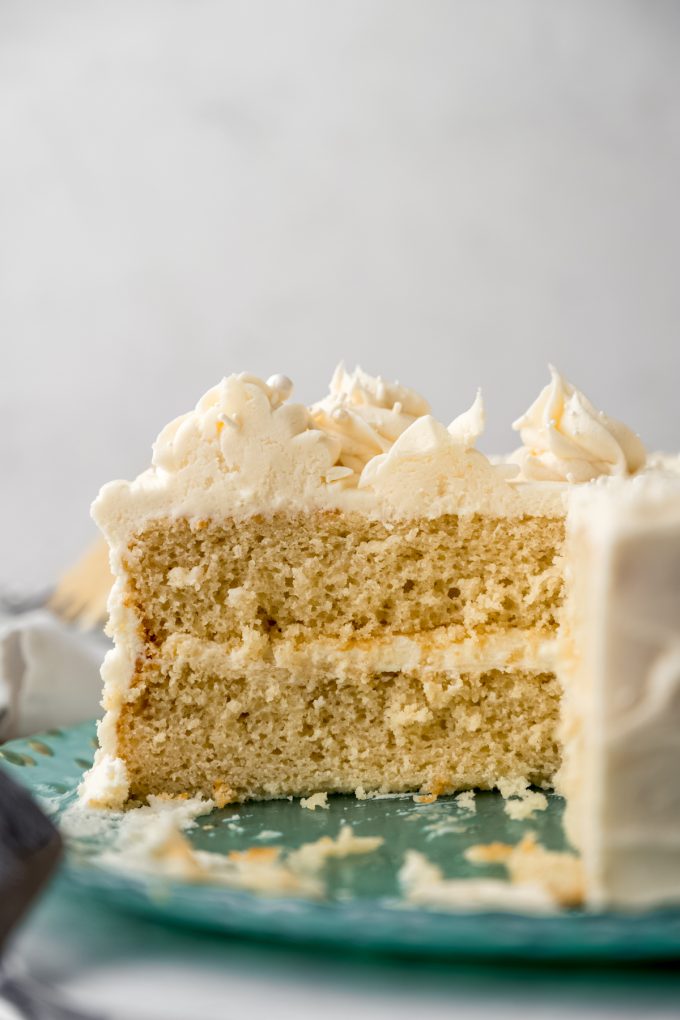

Frequently Asked Questions
The Best White Cake Recipe
Ingredients
CAKE
- 2 cups (240g) all-purpose flour be sure to measure properly
- 2 Tablespoons (15g) cornstarch
- 1 and ¾ cups (350g) granulated sugar
- 4 teaspoons baking powder
- 1 teaspoon salt
- 12 Tablespoons (171g) unsalted butter softened to room temperature1
- 1 cup (240mL) whole milk room temperature1,2
- 6 large egg whites3 room temperature1
- 2 and ½ teaspoons vanilla extract
VANILLA BUTTERCREAM
- 1 cup (227g) unsalted butter softened to room temperature
- 4 cups (480g) powdered sugar
- 1 teaspoon vanilla extract
- ¼ to ⅓ cup (60-80mL) heavy whipping cream
- ⅛ teaspoon salt
Instructions
CAKE
- Place oven rack on the middle setting and preheat the oven to 350ºF (177ºC). Grease and flour (or use homemade cake release) two 8" or 9" round4 cake pans.
- In a large bowl with a handheld mixer or the bowl of a stand mixer fitted with the paddle attachment, combine the flour, cornstarch, sugar, baking powder, and salt. Blend ingredients together on low until completely combined, about 1 minute.2 cups (240g) all-purpose flour, 2 Tablespoons (15g) cornstarch, 1 and ¾ cups (350g) granulated sugar, 4 teaspoons baking powder, 1 teaspoon salt
- Add the room temperature butter and beat mixture on low speed until it resembles sand (see photo in post text). Scrape down the sides and bottom of the bowl with a spatula and mix again on low for a few seconds until thoroughly combined.12 Tablespoons (171g) unsalted butter
- Combine the whole milk, egg whites, and vanilla extract in a large container with a spout (like a 2-cup glass measuring cup) and mix gently with a fork until blended.1 cup (240mL) whole milk, 6 large egg whites3, 2 and ½ teaspoons vanilla extract
- With the mixer speed on medium-low, add half of the milk mixture (about 1 cup) to the crumb mixture and mix until blended. Add the remaining milk mixture to the batter and beat again on medium-low until everything is incorporated. Turn the mixer off, scrape down the sides and bottom of the bowl with a spatula, and increase mixer speed to medium. Beat the batter for about 30 seconds until batter is smooth.
- Divide batter evenly between the two prepared cake pans. Bake cakes for about 26-28 minutes or until a toothpick or cake tester inserted in the center comes out clean and the tops are lightly browned. Remove from oven and allow cakes to cool in the pans completely on a wire rack before removing and assembling.
VANILLA BUTTERCREAM
- In a large bowl with a handheld mixer or a stand mixer fitted with the paddle attachment, beat the the butter on medium-high until smooth, about 2 minutes.1 cup (227g) unsalted butter
- Reduce the mixer to low, then slowly add the powdered sugar and salt and mix until everything is combined. Add the vanilla extract and mix again.4 cups (480g) powdered sugar, 1 teaspoon vanilla extract, ⅛ teaspoon salt, ¼ to ⅓ cup (60-80mL) heavy whipping cream
- Slowly add the milk or cream, watching for and stopping at desired consistency. Add the salt, then increase the mixer speed to medium and beat until completely smooth.
- If after beating, the frosting is too stiff, add more cream. If it is too thin, add more powdered sugar, about 2 Tablespoons at a time. Turn off the mixer and use a spatula to stir the buttercream by hand to remove air bubbles and make it smooth and creamy. This usually takes about 3-5 minutes, but can take longer, especially if your mixer is very strong. Buttercream is ready to use right away.
ASSEMBLE THE CAKE
- Trim cooled cake layers to create a flat surface. You can do this with a large serrated knife or a cake leveler. Place one layer on a plate or cake stand and cover the top with the vanilla buttercream frosting. Spread evenly with an offset spatula.
- Place second layer on top, cut surface down. For a sturdier cake, refrigerate at this point for about 10 minutes. When cake is slightly chilled, remove from refrigerator and spread more frosting on the top and around the sides. Serve. Leftovers stay fresh, covered tightly, at room temperature up to 5 days and in the refrigerator up to 1 week.
- Make ahead: prepare cakes and frosting up to 1 day in advance. Cover cakes tightly and keep at room temperature or in the refrigerator until ready to assemble. Refrigerate prepared frosting in an airtight container until ready to use. Unfrosted cake layers may be frozen, wrapped tightly, up to 2 months. Thaw overnight in the refrigerator before assembling. Frosted cake can be frozen, wrapped tightly, up to 2 months. Thaw overnight in the refrigerator and bring to room temperature before serving.
Video
Notes
- Room temperature ingredients: it is imperative to use room temperature ingredients in this recipe. Allow ingredients to sit out at room temperature at least 45 minutes before beginning.
- Whole milk: I strongly encourage using full fat whole cow milk in this recipe. It keeps the crumb moist and dense and adds a creaminess to the overall texture of the cake.
- Egg whites: you can use cartoned egg whites for this particular recipe. Aim for 30g per egg white as opposed to the 46g on the carton.
- Cake pans: this recipe has been tested with two 8″ round pans, but it will work in two 9″ pans OR three 8″ round pans. If using two 9″ pans, reduce bake time to 22-24 minutes. If using three 8″ pans, reduce bake time to 18-20 minutes.
- Sheet cake: you can also make this as a sheet cake.
Nutrition Disclosure
All nutritional values are approximate and provided to the reader as a courtesy. Changing ingredients and/or quantities will alter the estimated nutritional calculations.


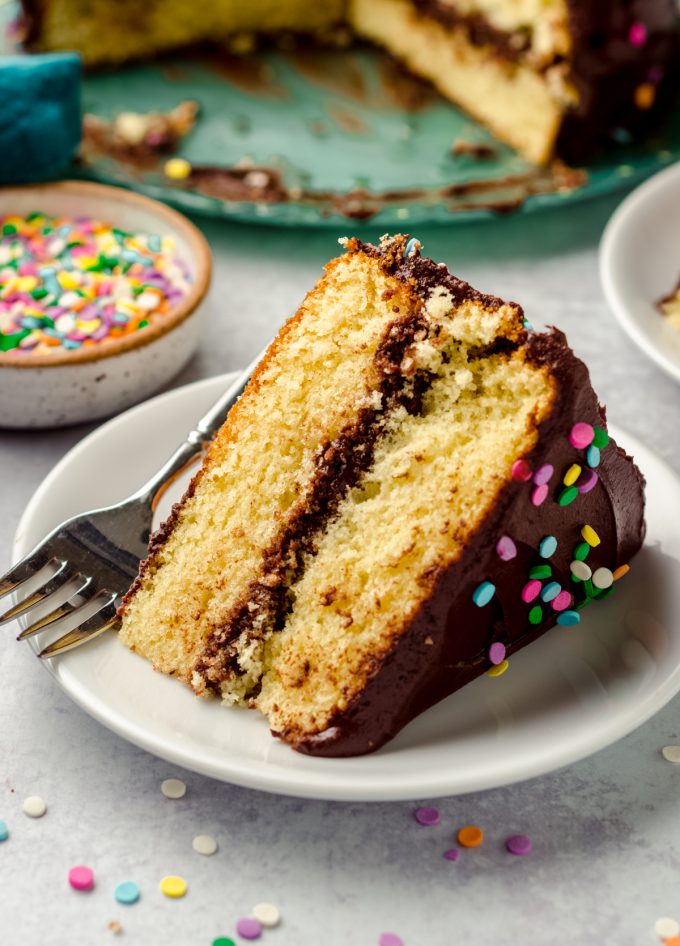
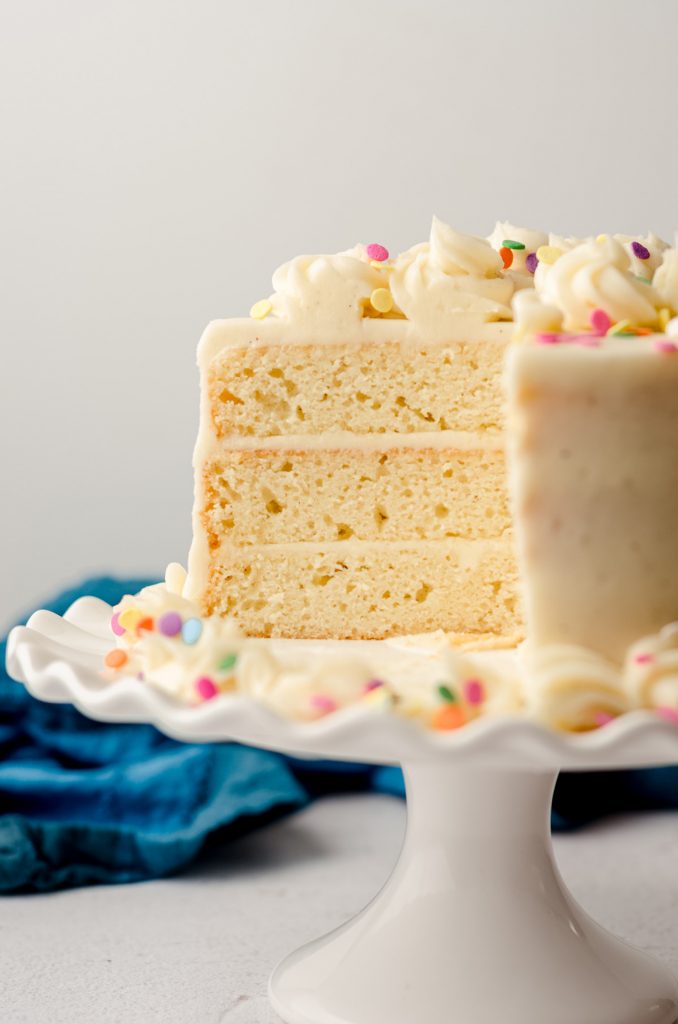
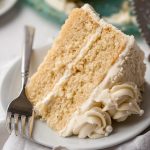
Can I use three whole eggs instead of six eggs whites? Thanks!
Hi, Olivia– no, that would be a yellow cake.
Awesome
Thanks so much, Autumn!
I see the mention of almond extract in the comments but not in the recipe. Do you use it in this cake? So, how much? I think a touch of it would be great.
Hi, Colleen– I originally used almond extract in this cake and in the frosting but removed it as over the years, I prefer it without! If you want to use some, I put 1 teaspoon in the cake and 1/2 teaspoon in the frosting. Enjoy!
This cake is absolutely fabulous! So light and fluffy with a ton of delicious vanilla flavor. I brought this cake to a birthday party and it was a huge hit!
I loved getting to try out the reverse creaming method; I had tried it once before, but the results this time around a definitely sold me on it.
Also, I didn’t have quite enough all-purpose flour at the time I was ready to start baking, so Lynn helped me adjust the recipe so I could use the cake flour I had in my pantry instead, and it worked like a charm. Thanks Lynn!
So happy to hear this, Sarah! Thank you so much for trusting this beloved cake 🙂